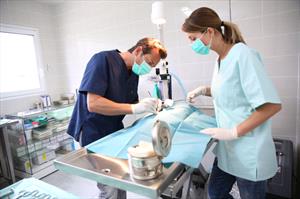Surgery

Photo courtesy of Depositphotos
A few weeks ago, my mother texted me a question many others likely have, “What are your thoughts on early spay/neuter?” I admit, I haven't replied. I stared at the text thinking, “My thumbs will fall off before I can give all of my thoughts on the matter.” So, this article is for you, Mom, and all the others out there with the same question.
When I was growing up, the decision of when to spay/neuter your pet was simple: do it when the pet reaches six months of age. By doing so, most pets would be fixed prior to puberty, which comes at different ages ranging from as young as five months old in cats and six months old in small breed dogs, up to a year or longer in large and giant breed dogs. At this time in my life, veterinarians had neither the anesthetics, the monitoring equipment, nor the training to feel like the surgery could be done safely in younger animals.
During my veterinary school years, a shift started to take place. Research into pediatric surgery and anesthesia protocols allowed veterinarians to consider surgery at a much younger age, as young as eight weeks. This was huge! The biggest drawback to the six-months-old spay/neuter rule was that puppies and kittens would be adopted from shelters with vouchers to get the surgery done when they were old enough. Too often that didn't happen. Shelters would adopt out these kids but then would see their litters surrendered several months later when owners didn't get them desexed on time and the now-past-puberty pets got pregnant. This problem became a big motivator for shelter veterinarians to perfect what is often called early spay/neuter, that done prior to six months of age. Now it is common for veterinarians, particularly those in shelters, to sterilize puppies and kittens as early as six weeks of age.
There are big advantages to this! When animals are desexed prior to leaving the shelter, there is no risk of an owner forgetting to have it done later. Which means those pets won't produce unwanted litters that are then surrendered to shelters. Early spay/neuter has been instrumental in reducing the annual euthanasia of unwanted dogs and cats from about 3.7 million in 2008 to about 1.5 million animals ten years later. Like children, kittens and puppies often recover faster from surgery than their older counterparts. Early sterilization can all but eliminate certain types of cancer such as mammary cancer in cats and can decrease the chances of other conditions such as benign prostatic hyperplasia in dogs. And with numerous advances in anesthesia, monitoring equipment, and surgical technique, early spay/neuter is quite safe.
The issue changes however when you start talking about individual animals and not populations. Just like with people, what might be best for a shelter population of many dogs and cats might not be quite right for your individual dog or cat. And that's where it gets tough. Frankly, it's easier to have a blanket rule for everyone. The conversation in the exam room is faster when it's, “Spay her before six months of age.” When the conversation instead has to dig into the individual variances of a particular dog or cat and the differing goals of a particular owner, quite simply it takes longer and is more complicated. Nuances have to be considered. No longer is it the advice of all veterinarians, but now it is the agreement between a given owner and her veterinarian as to when the time is right for this specific pet (which may not be the same for any other pet in the same home!).
There have been studies showing potential harm from desexing specific breeds prior to puberty. The results are often preliminary involving small numbers of animals, but they do point to the possibility of increased orthopedic issues, urinary problems, and cancers in certain breeds when desexed early. More studies are on-going, and until we have more data, we can't really say if the risks of early spay/neuter outweigh the rewards for these particular breeds.
And so, the answer to the question of “When should I spay/neuter my pet?” is, “It depends.” If you get your pet from an animal shelter, then do not fear the fact that it will likely come already desexed. Be grateful that they have done that for you and enjoy your new pet!
However, if you obtain your pet intact from a breeder or elsewhere, I recommend an in-depth conversation with your veterinarian. If you have it available, bring information about the parents and grandparents of the new pet to your appointment. Be ready to discuss what you want from your new family member and what is right for your household. Do you want to breed him or her? And if so, are you willing to do appropriate testing prior to breeding to make sure your pet won't pass along any genetic issues? Are there known problems in the family line with other animals from this breeder? What activities do you plan to do with your pet? Is this dog solely a companion or will she be participating in dog shows, field work, or agility? How willing are you to put up with a cat or dog in heat in your home? Can you be certain she won't have an unwanted pregnancy and add to the pet overpopulation issue? Can you be sure he won't dig under the fence trying to get to a female in heat? The veterinarian will need your input in order to give you the best advice on when to have this particular pet, your pet, spayed or neutered.
More information on spaying and neutering cats and dogs:
Spaying your Female Dog
Spaying your Female Cat
Neutering your Male Dog
Neutering your Male Cat